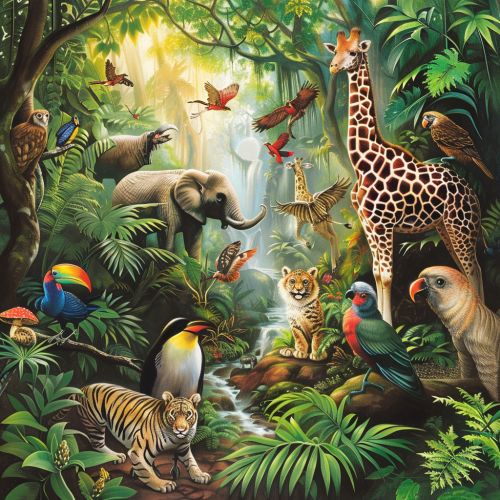Animal
Introduction
Animals are multicellular, eukaryotic organisms that form the biological kingdom Animal Kingdom. With few exceptions, animals consume organic material, breathe oxygen, are able to move, reproduce sexually, and grow from a hollow sphere of cells, the blastula, during embryonic development. Over 1.5 million living animal species have been described—of which around 1 million are insects—but it has been estimated there are over 7 million animal species in total. Animals range in size from 8.5 millionths of a metre to 33.6 metres long and have complex interactions with each other and their environments, forming intricate food webs.
Classification and Evolution
The study of animals is called zoology. Animals are one of the most diverse groups of organisms on the planet, and they are classified into various groups based on their characteristics. The most basic division is between the prokaryotes and the eukaryotes, which is based on the location of their DNA. Animals fall into the latter group, as their cells contain a nucleus.
The animal kingdom is further divided into several phyla. These include the Porifera (sponges), Cnidaria (jellyfish, sea anemones), Platyhelminthes (flatworms), Nematoda (roundworms), Annelida (segmented worms), Mollusca (snails, clams, squids), Arthropoda (insects, spiders, crustaceans), Echinodermata (starfish, sea urchins), and Chordata (fish, amphibians, reptiles, birds, mammals).


Each of these phyla is further divided into classes, orders, families, genera, and species. This hierarchical system of classification, known as the Linnaean System, was developed by Carl Linnaeus in the 18th century and is still used today, albeit with some modifications.
The evolution of animals is a complex process that has taken billions of years. The earliest known animals are the Ediacaran biota, which lived around 600 million years ago. These were followed by the Cambrian explosion, a period of rapid evolutionary development when most of the major animal phyla appeared. This was followed by the evolution of fish, amphibians, reptiles, birds, and mammals.
Anatomy and Physiology
Animal bodies are made up of cells that are organized into tissues, which in turn form organs and organ systems. The basic body plan of an animal is determined during its embryonic development. In many animals, the body is divided into segments, each of which has a specific function.
The most complex organ in the animal body is the brain, which controls behavior and other body functions. The brain is part of the nervous system, which also includes the spinal cord and a network of nerves that extend throughout the body.
Animals also have a circulatory system for transporting nutrients and oxygen to cells and removing waste products. This system includes the heart, blood vessels, and blood. The respiratory system, which includes the lungs in mammals and gills in fish, is responsible for exchanging oxygen and carbon dioxide with the environment.
The digestive system, which includes the mouth, esophagus, stomach, and intestines, is responsible for breaking down food and absorbing nutrients. The excretory system, which includes the kidneys and bladder, removes waste products from the body.
The reproductive system is responsible for producing offspring. In most animals, this involves sexual reproduction, in which the offspring inherits genes from both parents.
Behavior and Ecology
Animal behavior is a complex field that involves the study of how animals interact with each other and their environment. This includes studying animal communication, mating behaviors, hunting and feeding behaviors, and social structure.
Many animals live in groups, which can provide benefits such as increased protection from predators and increased success in hunting. Some animals, such as bees and ants, live in highly structured social groups known as colonies.
Animals also have complex relationships with their environment. They play key roles in ecosystems, influencing the abundance and distribution of other species. For example, predators can control the population sizes of their prey, while herbivores can influence the growth of plants.


Conservation
Many animal species are threatened by human activities such as habitat destruction, pollution, and overhunting. Conservation efforts aim to protect these species and their habitats. This can involve creating protected areas, restoring habitats, and implementing laws to regulate hunting and trade.
Conservation also involves research to understand the needs of threatened species and to develop effective strategies for their protection. This can involve studying the species' ecology, behavior, and genetics.
